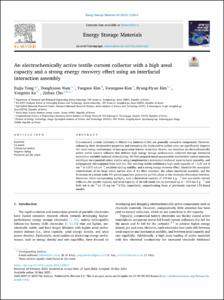An electrochemically active textile current collector with a high areal capacity and a strong energy recovery effect using an interfacial interaction assembly
- Title
- An electrochemically active textile current collector with a high areal capacity and a strong energy recovery effect using an interfacial interaction assembly
- Author(s)
- Yong, Euiju ; Nam, Donhyeon ; Kim, Yangsoo ; Kim, Kwangsoo ; Kim, Byung-Hyun ; Ko, Yongmin ; Cho, Jinhan
- Issued Date
- 2023-06
- Citation
- Energy Storage Materials, v.60
- Type
- Article
- Author Keywords
- Cu textile ; Lithium-ion battery ; Negative fading ; Polymeric gel-like phase
- Keywords
- LITHIUM-ION-BATTERY ; ELASTIC BAND METHOD ; ANODE MATERIAL ; LI4TI5O12 ANODE ; LI ; CUO ; PERFORMANCE ; ELECTRODES ; ORIGIN ; NANOPARTICLES
- ISSN
- 2405-8297
- Abstract
- Conventional current collectors in lithium-ion batteries (LIBs) are generally nonactive components. However, enhancing their electroactive properties and increasing the electroactive surface area can significantly improve the areal energy performance of next-generation battery electrodes. Herein, we introduce an electrochemically active textile current collector that delivers high energy storage performance, achieved through interfacial interaction assembly-induced electroplating. We first prepared metal nanoparticle/multiwalled carbon nanotube multilayer-incorporated cotton textiles using complementary interaction-mediated layer-by-layer assembly, and subsequently electroplated them with Cu. The resulting textile exhibited a high areal capacity of ∼3.27 mA h cm−2 at 0.875 mA cm−2, excellent cycling stability, and a strong energy recovery effect, thanks to the synergistic contributions of the large active surface area of the fibril structure, the robust interfacial assembly, and the formation of a metal oxide NP/pseudocapacitive polymeric gel-like phase at the electrode/electrolyte interface. Moreover, when incorporating Li4Ti5O12 with a theoretical capacity of 175 mA h g − 1 into our textile current collector, the specific capacity and areal capacity of the LIB anode can be increased up to ∼573 mA h g − 1 and 8.60 mA h cm−2 (at 15 mg cm−2 LTO), respectively, outperforming those of previously reported LTO-based anodes. © 2023
- Publisher
- Elsevier B.V.
- Related Researcher
-
-
Ko, Yongmin 에너지환경연구부
- Research Interests energy storage; energy conversion; thin film; layer-by-layer assembly; nanoparticle; rechargeable battery; supercapacitor
-
- Files in This Item:
-
 기타 데이터 / 13.89 MB / Adobe PDF
download
기타 데이터 / 13.89 MB / Adobe PDF
download
- Appears in Collections:
- Division of Energy Technology 1. Journal Articles



